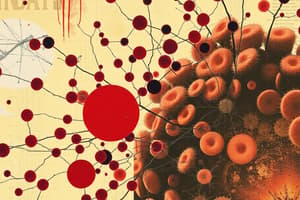Podcast
Questions and Answers
What is the precursor cell in granulopoiesis?
What is the precursor cell in granulopoiesis?
- Promyelocyte
- Hemocytoblast (correct)
- Myeloblast
- Myeloid stem cell
What cell type directly follows the myeloblast in the granulopoiesis maturation sequence?
What cell type directly follows the myeloblast in the granulopoiesis maturation sequence?
- Promyelocyte (correct)
- Metamyelocyte
- Myeloid stem cell
- Band form Granulocyte
Which of the following represents a mature cell type in the granulopoiesis pathway?
Which of the following represents a mature cell type in the granulopoiesis pathway?
- Myelocyte
- Granulocyte (correct)
- Band form Granulocyte
- Metamyelocyte
Which of the following is a stem cell involved in granulopoiesis?
Which of the following is a stem cell involved in granulopoiesis?
What cell type precedes the granulocyte directly?
What cell type precedes the granulocyte directly?
What is the appearance of chromatin in a mature cell?
What is the appearance of chromatin in a mature cell?
How does the nuclear to cytoplasmic ratio (NC ratio) differ between immature and mature cells?
How does the nuclear to cytoplasmic ratio (NC ratio) differ between immature and mature cells?
Which of these is a characteristic of immature cells?
Which of these is a characteristic of immature cells?
What is the typical shape of the nucleus in mature cells?
What is the typical shape of the nucleus in mature cells?
Which of the following is a characteristic of mature cells compared to immature cells?
Which of the following is a characteristic of mature cells compared to immature cells?
Which cell is the direct precursor to the promyelocyte in granulopoiesis?
Which cell is the direct precursor to the promyelocyte in granulopoiesis?
What is the defining characteristic of a band form granulocyte?
What is the defining characteristic of a band form granulocyte?
Which term describes the uncommitted precursor cell in the granulopoiesis process?
Which term describes the uncommitted precursor cell in the granulopoiesis process?
At which stage does the granulocyte lineage show a slight nuclear indentation?
At which stage does the granulocyte lineage show a slight nuclear indentation?
Which of the following represents the final mature stage in granulopoiesis?
Which of the following represents the final mature stage in granulopoiesis?
What is the main function of leukocytes?
What is the main function of leukocytes?
Which of the following is NOT a characteristic used to classify leukocytes?
Which of the following is NOT a characteristic used to classify leukocytes?
Which of the following is NOT a type of leukocyte?
Which of the following is NOT a type of leukocyte?
What is the general color of leukocytes compared to other blood cells?
What is the general color of leukocytes compared to other blood cells?
Which of the following is a characteristic shared by all leukocytes?
Which of the following is a characteristic shared by all leukocytes?
Which test is primarily used to analyze the lobe formation in polymorphonuclear leukocytes?
Which test is primarily used to analyze the lobe formation in polymorphonuclear leukocytes?
Which of the following tests would provide information about the different types of white blood cells present in a sample?
Which of the following tests would provide information about the different types of white blood cells present in a sample?
Which of the following is likely involved in identifying specific cell types based on surface markers?
Which of the following is likely involved in identifying specific cell types based on surface markers?
What type of test evaluates the presence and activity of enzymes within cells?
What type of test evaluates the presence and activity of enzymes within cells?
Which term refers to the assessment of the weight of each leukocyte type in a given sample?
Which term refers to the assessment of the weight of each leukocyte type in a given sample?
What is the first cell in the granulocyte development process?
What is the first cell in the granulocyte development process?
What is a key difference in the chromatin structure between immature and mature cells?
What is a key difference in the chromatin structure between immature and mature cells?
At which stage does the cell become a pre-granulocyte?
At which stage does the cell become a pre-granulocyte?
Which cell represents an intermediate stage between the myeloblast and granulocyte?
Which cell represents an intermediate stage between the myeloblast and granulocyte?
Which statement accurately describes the nucleoli in mature cells?
Which statement accurately describes the nucleoli in mature cells?
Which of the following is the stage after the promyelocyte in granulopoiesis?
Which of the following is the stage after the promyelocyte in granulopoiesis?
How does the nuclear to cytoplasmic ratio (NC ratio) change from immature to mature cells?
How does the nuclear to cytoplasmic ratio (NC ratio) change from immature to mature cells?
Which option accurately describes the size of mature cells compared to immature cells?
Which option accurately describes the size of mature cells compared to immature cells?
What type of cell is a myeloid stem cell responsible for differentiating into?
What type of cell is a myeloid stem cell responsible for differentiating into?
What is a typical feature of the nucleus in immature cells?
What is a typical feature of the nucleus in immature cells?
What is the primary function of leukocyte kinetics?
What is the primary function of leukocyte kinetics?
Which of the following is NOT a body compartment involved in leukocyte kinetics?
Which of the following is NOT a body compartment involved in leukocyte kinetics?
Which compartment contains the precursors of leukocytes before they enter circulation?
Which compartment contains the precursors of leukocytes before they enter circulation?
What are the dynamic forces responsible for leukocyte movement primarily involved with?
What are the dynamic forces responsible for leukocyte movement primarily involved with?
In the context of leukocyte movement, which of the following best describes 'peripheral blood'?
In the context of leukocyte movement, which of the following best describes 'peripheral blood'?
What is measured by the Arneth Count?
What is measured by the Arneth Count?
Which laboratory test is used for evaluating vitamin B12 absorption?
Which laboratory test is used for evaluating vitamin B12 absorption?
Which of the following tests would provide information about the functional status of white blood cells?
Which of the following tests would provide information about the functional status of white blood cells?
What are the three body compartments where leukocytes can be found?
What are the three body compartments where leukocytes can be found?
Which group is characterized by a higher percentage of lobes in the Arneth count according to its diagram?
Which group is characterized by a higher percentage of lobes in the Arneth count according to its diagram?
What type of staining method is primarily involved in identifying specific protein expressions in cells?
What type of staining method is primarily involved in identifying specific protein expressions in cells?
Which compartment contains leukocytes before they enter the peripheral blood?
Which compartment contains leukocytes before they enter the peripheral blood?
Where do leukocytes primarily carry out their immune functions?
Where do leukocytes primarily carry out their immune functions?
Which of the following statements about leukocyte movement is true?
Which of the following statements about leukocyte movement is true?
Flashcards
Granulopoiesis
Granulopoiesis
The process by which granulocytes, a type of white blood cell, are developed.
Hemocytoblast
Hemocytoblast
The first stage in the development of granulocytes.
Myeloid stem cell
Myeloid stem cell
The stem cell that gives rise to various blood cells, including granulocytes.
Myeloblast
Myeloblast
Signup and view all the flashcards
Promyelocyte
Promyelocyte
Signup and view all the flashcards
Immature cell size
Immature cell size
Signup and view all the flashcards
Nucleoli in immature cells
Nucleoli in immature cells
Signup and view all the flashcards
Chromatin in immature cells
Chromatin in immature cells
Signup and view all the flashcards
Nucleus in immature cells
Nucleus in immature cells
Signup and view all the flashcards
Nuclear/Cytoplasmic ratio
Nuclear/Cytoplasmic ratio
Signup and view all the flashcards
Granulocyte
Granulocyte
Signup and view all the flashcards
Metamyelocyte
Metamyelocyte
Signup and view all the flashcards
Band Form
Band Form
Signup and view all the flashcards
WBC Count
WBC Count
Signup and view all the flashcards
WBC Differential Count
WBC Differential Count
Signup and view all the flashcards
Schilling's Index
Schilling's Index
Signup and view all the flashcards
Arneth Count
Arneth Count
Signup and view all the flashcards
Cytochemical Stains
Cytochemical Stains
Signup and view all the flashcards
Leukocyte Kinetics
Leukocyte Kinetics
Signup and view all the flashcards
Bone Marrow
Bone Marrow
Signup and view all the flashcards
Peripheral Blood
Peripheral Blood
Signup and view all the flashcards
Tissues
Tissues
Signup and view all the flashcards
Bone Marrow, Peripheral Blood, Tissues
Bone Marrow, Peripheral Blood, Tissues
Signup and view all the flashcards
What is Granulopoiesis?
What is Granulopoiesis?
Signup and view all the flashcards
What is Leukocyte Kinetics?
What is Leukocyte Kinetics?
Signup and view all the flashcards
What is the role of Bone Marrow in Leukocyte Kinetics?
What is the role of Bone Marrow in Leukocyte Kinetics?
Signup and view all the flashcards
What is the role of Peripheral Blood in Leukocyte Kinetics?
What is the role of Peripheral Blood in Leukocyte Kinetics?
Signup and view all the flashcards
What is the role of Tissues in Leukocyte Kinetics?
What is the role of Tissues in Leukocyte Kinetics?
Signup and view all the flashcards
How do leukocytes move between compartments?
How do leukocytes move between compartments?
Signup and view all the flashcards
What are Leukocytes?
What are Leukocytes?
Signup and view all the flashcards
How are Leukocytes classified?
How are Leukocytes classified?
Signup and view all the flashcards
What are Granulocytes?
What are Granulocytes?
Signup and view all the flashcards
What are Agranulocytes?
What are Agranulocytes?
Signup and view all the flashcards
Where do Leukocytes travel?
Where do Leukocytes travel?
Signup and view all the flashcards
What is an Arneth Count?
What is an Arneth Count?
Signup and view all the flashcards
What are Cytochemical Stains?
What are Cytochemical Stains?
Signup and view all the flashcards
What is a WBC Differential Count?
What is a WBC Differential Count?
Signup and view all the flashcards
What is Immunophenotyping?
What is Immunophenotyping?
Signup and view all the flashcards
Immature Cells: Nucleoli
Immature Cells: Nucleoli
Signup and view all the flashcards
Immature Cells: Nuclear/Cytoplasmic Ratio
Immature Cells: Nuclear/Cytoplasmic Ratio
Signup and view all the flashcards
Immature Cells: Chromatin
Immature Cells: Chromatin
Signup and view all the flashcards
Immature Cells: Nucleus
Immature Cells: Nucleus
Signup and view all the flashcards
Study Notes
Granulopoiesis
- Granulopoiesis is the process of forming granulocytes
- The process begins with a myeloid stem cell
- Hemocytoblast is the precursor cell for granulocytes
- Myeloblast is the next step after Hemocytoblast
- Promyelocyte is the next step after Myeloblast
- Myelocyte is the next step after Promyelocyte
- Metamyelocyte is the next step after Myelocyte
- Band form is the next step after Metamyelocyte
- Granulocyte is the final stage
Studying That Suits You
Use AI to generate personalized quizzes and flashcards to suit your learning preferences.




